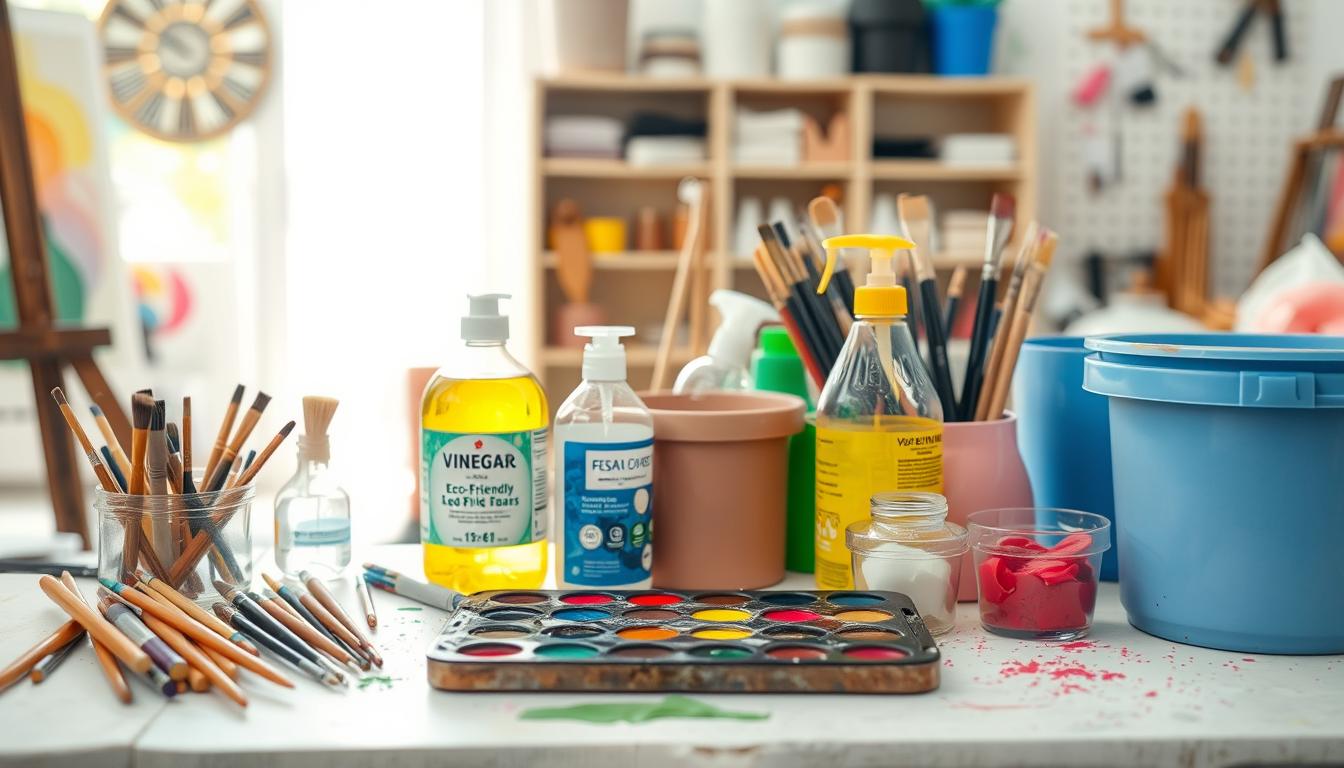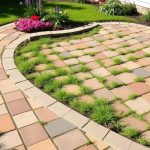Welcome to our comprehensive guide on paint clean-up. We’ll explore the importance of using the right tools, tips, and eco-friendly solutions. Paint clean-up is crucial in any painting project. The right cleaning solutions can significantly impact the outcome. We’ll discuss the best practices, including eco-friendly methods and effective solutions.
Proper paint clean-up techniques are vital for a safe and healthy environment. By adopting eco-friendly methods and using the right tools, waste can be minimized. Our aim is to equip you with the knowledge and skills for efficient and sustainable clean-up. This guide is for both professional painters and DIY enthusiasts, offering essential information for success.
Introduction to Paint Clean-Up
Paint clean-up is more than just cleaning spills and splatters. It demands a deep understanding of paint types and their clean-up needs. From latex to oil-based paint, each has unique characteristics and requirements. Knowing these differences helps you select the best cleaning solutions and tools.
Key Takeaways
- Use eco-friendly cleanup methods to minimize waste and reduce environmental pollution
- Choose the right cleaning solutions for the type of paint you’re using
- Invest in the right tools, such as paintbrushes and rollers, to make paint clean-up easier
- Follow proper safety protocols to avoid accidents and injuries
- Consider recycling paint containers and disposing of paint responsibly
- Use paint clean-up as an opportunity to maintain and care for your painting tools and equipment
Essential Paint Clean-Up Tools and Materials
Effective paint clean-up requires the right tools and materials. You’ll need basic cleaning supplies, specialized paint removal tools, and safety gear. Proper tool maintenance is key to extending your tools’ lifespan and ensuring they work well.
Start by collecting basic cleaning items like rags, soap, and water. These are vital for cleaning cleaning brushes and other tools. For tougher paint spills, you might need scrapers and solvents. Don’t forget safety gear like gloves and masks to shield against paint fumes and skin irritation.
Here are some must-have tools and materials:
- Rags
- Soap and water
- Scrapers
- Solvents
- Gloves
- Masks
- Paint removal tools
Regular cleaning brushes and tool maintenance prevent paint from drying on them. This makes paint removal simpler. With the right tools and materials, and proper maintenance and safety, you’ll achieve a successful paint clean-up.
Always adhere to safety guidelines and use the correct tools to avoid damage or injury. With the right equipment and a bit of practice, you’ll master paint clean-up quickly.
Understanding Different Paint Types and Their Clean-Up Requirements
Understanding the various paint types and their clean-up requirements is crucial. This knowledge allows you to tailor your clean-up approach to the specific paint type. It ensures a more efficient and safe clean-up process.
There are several paint types, including latex, oil-based, and epoxy. Each paint type has its own clean-up requirements. For instance, latex paint can be cleaned up with soap and water. In contrast, oil-based paint requires mineral spirits or turpentine. Epoxy paint necessitates a specialized cleaner.
Here are some key things to consider when it comes to paint types and their clean-up requirements:
- Latex paint: easy to clean up with soap and water
- Oil-based paint: requires mineral spirits or turpentine for clean-up
- Epoxy paint: requires a specialized cleaner
By understanding the different paint types and their clean-up requirements, you can ensure a safe and efficient clean-up process. This knowledge helps you choose the right cleaning products and techniques. It makes the clean-up process easier and more effective.
Proper Paint Clean-Up Techniques for Various Surfaces
Cleaning paint from different surfaces requires the right techniques and cleaning solutions to prevent damage. Whether it’s walls, floors, carpets, or fabrics, acting quickly and testing a small area first is crucial. This step helps determine the best method for paint removal and ensures a successful clean-up.
For walls and floors, a soap and water mixture often works for paint spills. But for tougher stains, specialized cleaning solutions for the surface type might be needed. Remember, proper disposal of paint and cleaning materials is key to reducing environmental impact.
Cleaning Paint from Specific Surfaces
- Walls: Use a soft cloth and mild detergent to avoid damaging the paint or wallpaper.
- Floors: Apply a cleaning solution designed for the floor type, like hardwood or tile.
- Carpets and fabrics: Blot the stain with a clean cloth and apply a gentle cleaning solution, then rinse with cold water.
Always follow the manufacturer’s instructions for cleaning products and take safety precautions to avoid accidents. By employing the correct techniques and cleaning solutions, you can achieve a successful paint clean-up and proper disposal of materials.
| Surface Type | Cleaning Solution | Technique |
|---|---|---|
| Walls | Mild detergent | Soft cloth and gentle scrubbing |
| Floors | Specialized floor cleaner | Mop or soft cloth and gentle scrubbing |
| Carpets and fabrics | Gentle cleaning solution | Blotting and rinsing with cold water |
Professional Brush and Roller Maintenance
Keeping painting tools in top shape is vital for their longevity and performance. Cleaning brushes and maintaining tools are key steps in this process. Regular cleaning prevents paint from drying on brushes, making them easier to use and maintain.
For natural bristle brushes, use mild soap and warm water for cleaning. This method prevents bristle damage and keeps them soft and flexible. Synthetic brushes can be cleaned with soap and water, but harsh chemicals should be avoided to prevent bristle damage.
Cleaning and Shaping Brushes
To clean and shape brushes, first remove excess paint from the bristles. Then, use mild soap and warm water to clean them, starting from the base to the tip. Finish by wiping with a clean cloth to remove excess water and restore the brush’s shape.
Maintaining Rollers
Roller maintenance is equally important. Clean rollers with soap and water after each use and let them dry completely before storage. This prevents paint from drying on the rollers, making them easier to use for future projects.
By following these simple steps, you can extend the life of your painting tools and ensure they remain in good condition for future projects. Regular cleaning and maintenance are crucial for keeping brushes and rollers in top condition. This ensures professional-looking results in your work.
| Tool | Cleaning Method | Maintenance Tips |
|---|---|---|
| Natural Bristle Brushes | Mild soap and warm water | Reshape after cleaning, store in a dry place |
| Synthetic Brushes | Mild soap and water | Avoid harsh chemicals, store in a dry place |
| Rollers | Soap and water | Allow to dry completely before storing |
Eco-Friendly Paint Clean-Up Solutions
Many of us turn to harsh chemicals for paint clean-up, neglecting the environmental toll. Fortunately, eco-friendly alternatives exist, ensuring safety for both us and the planet. Natural solvents, like citrus-based cleaners, and water-based cleaners devoid of toxic chemicals, are viable options.
Proper disposal is key in eco-friendly paint clean-up. This entails recycling paint containers and disposing of rags and other materials responsibly. Such practices greatly diminish the environmental footprint of paint clean-up.
- Using reusable cleaning cloths instead of paper towels
- Choosing water-based paints that are easier to clean up
- Avoiding the use of harsh chemicals and opting for natural solvents instead
Adopting eco-friendly clean-up methods can significantly impact the environment. Every small change in our paint clean-up routine matters. By embracing these practices, we contribute to a greener future.
“The greatest threat to our planet is the belief that someone else will save it.” This quote highlights the need for personal responsibility and eco-friendly choices, including in paint clean-up.
| Eco-Friendly Clean-Up Method | Benefits |
|---|---|
| Natural Solvents | Non-toxic, biodegradable, and gentle on surfaces |
| Water-Based Cleaners | Low VOCs, easy to use, and effective |
| Proper Disposal | Reduces waste, conserves resources, and protects the environment |
Safe Paint Disposal Methods and Guidelines
Proper paint disposal is key to a safe and healthy environment. It’s crucial to follow the right guidelines to avoid harming the environment and human health. Paint disposal might seem tricky, but with the right knowledge, you can do it correctly.
Understanding the different types of paint and their disposal requirements is vital. Latex paint can be recycled or dried out and then thrown away. In contrast, oil-based paint is hazardous waste and needs special handling.
Latex Paint Disposal
Latex paint can be recycled or taken to a local recycling center. Many communities have facilities for paint disposal. Be sure to check with your local government for more information.
Oil-Based Paint Disposal
Oil-based paint is hazardous waste and requires special handling. It must be taken to a hazardous waste collection facility for proper disposal. Always check with your local government for guidelines on proper disposal methods.
Remember, paint disposal is not just about getting rid of the paint. It’s also about recycling the containers and minimizing waste. By following these guidelines and taking the necessary steps, you can ensure safe and environmentally friendly paint disposal.
| Type of Paint | Disposal Method |
|---|---|
| Latex Paint | Recycling or drying out |
| Oil-Based Paint | Hazardous waste collection facility |
Preventing Paint Spills and Accidents
Prevention is crucial in avoiding the hassle and danger of paint spills. To minimize accident risks, prepare the workspace adequately. This involves covering floors and surfaces with drop cloths, ensuring good ventilation, and removing any furniture or items that could be damaged by paint.
A well-prepared workspace significantly reduces the risk of paint spills and accidents. By setting up the area correctly, you can avoid the need for costly paint removal and cleaning solutions. Some essential tips for workspace preparation include:
- Using high-quality drop cloths to protect floors and surfaces
- Ensuring good ventilation to prevent the buildup of fumes
- Removing any furniture or items that could be damaged by paint
- Wearing protective gear, such as gloves and masks, to safeguard against paint exposure
Professional protection methods are also vital in preventing paint spills and accidents. This includes using paint with low VOCs (Volatile Organic Compounds) and following proper painting techniques. By taking a proactive approach to paint removal and cleaning solutions, you can ensure a safe and successful painting experience.
By following these tips and taking the necessary precautions, you can prevent paint spills and accidents, and ensure a successful painting experience. Remember, prevention is key when it comes to paint removal and cleaning solutions. So, take the time to prepare your workspace and protect yourself and your surroundings.
Troubleshooting Common Paint Clean-Up Problems
When dealing with paint clean-up, unexpected problems can pop up, making the task harder. It’s crucial to have the correct cleaning solutions and methods to overcome these challenges. Issues often include tough paint stains, spills on various surfaces, and paint that’s hard to remove from certain materials.
Some common problems and their solutions include:
- Paint stains on carpets: Use a cleaning solution made for paint removal, and gently blot the stain.
- Paint spills on wood: Act fast, and use a cleaning solution to remove the paint before it dries.
- Difficulties in removing paint from metal: Use a paint remover or a cleaning solution made for metal surfaces.
With the right paint clean-up techniques and cleaning solutions, you can handle unexpected problems and achieve a successful clean-up. Always follow safety guidelines and wear protective gear when working with paint and cleaning solutions.
Conclusion: Making Paint Clean-Up Simple and Sustainable
This guide has given you a deep dive into eco-friendly paint clean-up practices. By using the right tools, techniques, and disposal methods, you can make your painting projects simple and sustainable. Remember, proper paint clean-up not only protects the environment but also safeguards your health and well-being.
By adopting eco-friendly cleanup solutions, like biodegradable solvents and proper paint waste disposal, you show your commitment to responsible stewardship. Apply the knowledge from this guide to make your painting experiences more efficient, environmentally conscious, and satisfying. With a little effort and the right approach, you can enjoy the beauty of a freshly painted space while minimizing your impact on the planet.


